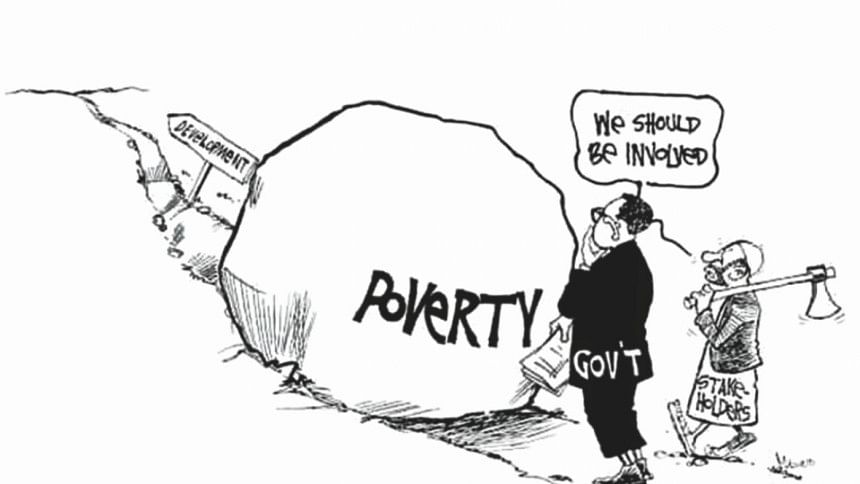PROTECT THE POOREST

The honourable Prime Minster Sheikh Hasina has promised to eradicate extreme poverty by 2021 and has made remarkable progress towards this goal. Over the past five years, an estimated 10 million people have made the catalytic leap out of extreme poverty and onto the first rung of the economic ladder. This has been possible because our government has recognized the extreme poor as a group very different from the poor, a group with different needs.
The extreme poor need livelihood support to 'graduate' out of extreme poverty, over and above monthly support such as safety net transfers to meet daily consumption needs. Successful livelihood programmes such as BRAC's CFPR and those nested within the LGRD ministry have contributed to the goal. To empower the remaining 15 million people (3 million families) to climb out of extreme poverty, we need scaled up livelihood programmes (for graduation) and effective safety nets that reach the poorest.
The government's formulation of a National Social Security Strategy (NSSS) is a positive step forward. The strategy highlights the need for a consolidation of safety net programmes, collaboration between ministries, a lifecycle approach to meet the changing needs of individuals and modern technology for efficient management overall.
Efficient targeting, selection and enrolment of the poorest
According to the Union Parishad Law, beneficiaries of safety net programmes should be picked at public assemblies (ward shobhas) by the community themselves. In reality, these meetings are irregular and the task of selection falls upon the union chairman who could just as well toss a coin to decide who should or should not receive support. In other countries, to facilitate fair and transparent selection, a single central registry of the extreme poor is developed with the help of community participation and clear targeting criteria. Perhaps, we too should develop a single central registry of the 3 million extremely poor families that need attention and support. A digital database of this sort can be used to identify what stage of the lifecycle extremely poor people are at, in order to match them to suitable safety nets.
Targeted support to deal with shocks
Even with regular safety net support, shocks such as floods, theft, eviction, illness, death and disability can throw a family back into the trenches of extreme poverty. These shocks need to be dealt with on a household by household basis. One NGO managed this challenge by empowering its field staff with mobile phones to collect data on households regularly so that support packages could be quickly delivered to families struggling to cope with shocks. This model could be replicated by empowering local government officers with smartphones and training to collect critical real-time data. Since health shocks are the most frequent cause of descent into the clutches of extreme poverty, health insurance and better delivery of free health care services need to be developed. Many mobile-based health solutions are gaining popularity in Bangladesh and elsewhere. Perhaps the extreme poor should be brought into the fold of such services too.
Educational training coupled with social transfers
The extreme poor are predominantly uneducated so to ensure that government entitlements are used wisely, transfers should be accompanied by training. The World Food Programme (WFP) conducted a study this year with Vulnerable Group Development (VGD)/Vulnerable Group Feeding (VGF) that proved when transferring cash or food, if behavioural change communications (BCC) are included, the impact on the lives of the extreme poor is much greater. Shiree/ BRAC's models rightly recognise the importance of field officers who deal with 100-200 families each, often dedicating themselves with passion and commitment to provide support and coaching to ensure these families are able to graduate. EBEK also has a strong field force, however, they have not had the same level of training that the donor-driven field staff have had. In the future, mobile educational content may be a viable way to transfer knowledge around key livelihood topics, both to train field officers and to directly educate beneficiaries.
Mechanism for impact monitoring
A major shortcoming of the previous safety net programmes was the absence of a monitoring and evaluation system. There was no formal mechanism for reviewing the performance of the programmes either at the national or individual level. NSSS has assigned this task to a Central Monitoring Committee under the Cabinet Secretary. When measuring the impact of safety nets on the extreme poor, multi-dimensional poverty indicators should be considered. This data can help identify what works and what does not, so successful programmes can be scaled up and unsuccessful ones, closed down. Performance measures can also be used to incentivise union chairmen and local government officers to better serve the poorest by attaching rewards to these measures.
Technology is not the panacea to all ailments in the fight against poverty but it certainly can improve the efficiency of large-scale programmes and should be applied to benefit the poorest! To increase the use of technology in managing and monitoring safety nets, local government access to technology needs to be increased through education and awareness. Fear and resistance to technology at a local, district and national level needs to be overcome. More user-friendly (Bangla/icon-based) materials need to be developed set in this context.
Thanks to the innovative Digital Bangladesh initiative and the efforts of the ICT ministry and A2I, Bangladesh is poised to take advantage of modern technology in a way that other SAARC or African countries are not. With creative technology, our current political will and a strategic implementation of the NSSS, Bangladesh can surge ahead to achieve the SDG goal of eradicating extreme poverty, by our 50th birthday, and WOW, what an achievement that would be!
The writer is head of Progress Tracker at MPower Social.
Email: [email protected]

 For all latest news, follow The Daily Star's Google News channel.
For all latest news, follow The Daily Star's Google News channel. 



Comments